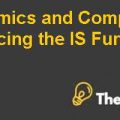
Discuss how Yokohama responded to its customers' target costing systems? (10 marks)
Yokohama responded to its customers' target costing systems by focusing more on building strong supplier-customer relationships. These relationships were taken very seriously and often ranged back to the whole supply chain through a type of backward integration. The company’s competencies were utilized efficiently throughout the chain.
The key to succeed for companies like Yokohama was to maintain close relations with suppliers to find out profitable deals that are mutually beneficial. If the metal forgings suppliers were good at designing a forged part, they were paid additionally to do so. It not only increased revenues of forgings suppliers but it also reduced the cost for Yokohama.
The entire supply chain from raw material to finished product was working efficiently to utilize resources in a well arranged manner so that everyone can be benefitted. Engineers worked together to make a design that is unique and cost efficient. This initiative taken by the company helped it to remain cost efficient as tasks were assigned to respective departments that were working together to help the company and add value to the product.
- 1. What is a minimum cost investigation (MCI)? Critically assess the usefulness of the MCI technique to value creation in the Tokyo Motors-Yokohama-Kamakura supply chain. (15 marks)
The Minimum Cost Investigation (MCI) was designed for Toyota Motors to reduce the cost of the company and companies involved in the supply chain. In this meeting all suppliers sat together and discussed the possible improvements in the designing of products. According to this initiative, the cost information at each step involved in the production was gathered and ways were searched through which those costs could be reduced. Alternatives were generated to develop inexpensive parts of the product and its feasibility was analyzed. Proposals/alternatives that were approved were implemented.
Assessment
Through MCI, the flaw of target costing of neglecting the profit margin of Yokohama and other companies in the supply chain was eliminated. However, in this system Tokyo Motors was well aware of the margins that companies were keeping. Companies could not charge a high cost at any step of the process. The major advantage in this costing system was that Yokohama could request an MCI meeting if it believed that it could not manufacture the part profitably at its target price. Suggestions were appreciated if they could manage to reduce the price to make the deal profitably.
Solutions would not have been possible if all the three firms did not meet to share ideas. The low-cost solutions were identified and implemented. Along with that, companies in the supply chain had the freedom to reject any proposal if they could not deliver at at the target price profitably. Through this process, the excess supplier pressure was avoided.
Yokohama's management believed that developing such a culture was critical to its survival because it ensured that the firm did not become dependent on its customers. The whole supply chain was useful for everyone involved in it. There existed a value creation in the Tokyo Motors-Yokohama-Kamakura supply chain through negotiations among the firms. However, suppliers felt that Tokyo Motors had too much leverage in negotiations because they had access to all the cost structure so they tried to minimize their margins to the maximum possible extent.
The most important benefit that Yokohama had was that it could refuse to sell products at the target price identified by the customer because customers would clearly know that suppliers’ costs are higher or they are not benefitted. Thus, relations were not affected. Yokohama had to ensure its survival, thus it could not accept unprofitable contracts. The risk of the company was low because losing a single order from any one of them did not affect the firm and companies that could efficiently manage to supply the product were offered the deal. Hence, everyone operated at their competency level.
- 2. Critically evaluate the three cost reduction pathways of the YPS in the light of materials studied in this course. (21 marks)
Yokohama ensured its survival by manufacturing products at low costs. Yokohama production system (YPS) was an integrated set of cost reduction program which was developed by the company to work efficiently. The efficiency of the work force was improved through this system. This system worked through three pathways. All the pathways served different purposes for reducing costs through different means.
Capital Investment
The objective of this pathway was to reduce costs through capital investments to reduce head count. The new technology was selected after careful thinking. The technical staff arranged the request process to order the new equipment. This process involved members and employees from different departments so that suggestions are taken from a diversified portfolio about how and what equipment will add the maximum value to the organization. After all formalities are completed, the equipment was bought and properly installed......................................
This is just a sample partial case solution. Please place the order on the website to order your own originally done case solution.












